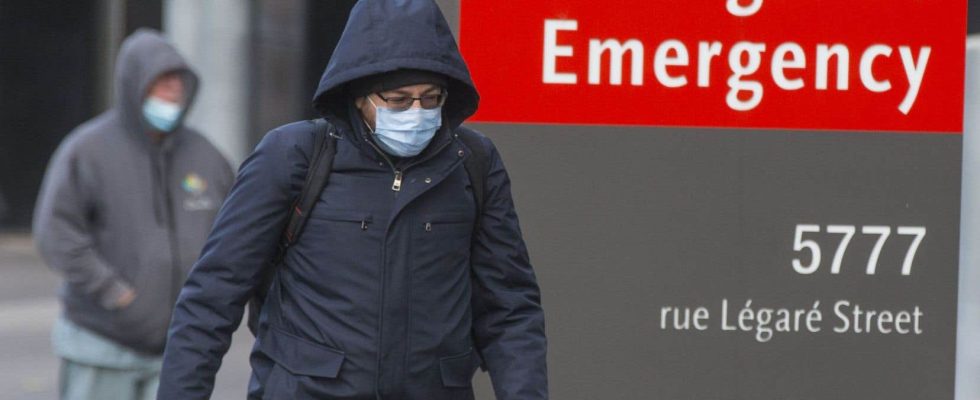After a “quiet” of a few months, the emergency rooms are again taken by storm by Quebecers. “Monster” traffic, “tsunami” of patients, “critical” situation : the staff on the ground has no shortage of qualifiers to describe the congestion that has persisted for a week. The crisis cell set up by Quebec last October is monitoring the situation closely.
The Dr Gilbert Boucher, president of the Association of Emergency Medicine Specialists of Quebec (ASMUQ) and member of the crisis unit, considers the situation “worrying”. For eight days, the stretcher occupancy rate has exceeded 140% in many hospitals. Tuesday morning, this percentage rose to 225% at the Jewish General Hospital, 218% at the Royal Victoria Hospital and 184% at the Hull Hospital, according to Index Santé. It exceeded 170% at the hospitals of Saint-Eustache, Saint-Jérôme, Lakeshore and Anna-Laberge.
The waiting rooms are also overflowing with patients. “Last week, the percentage of patients who left without seeing a doctor went up to 13%, indicates the Dr Butcher. We had reduced this rate in January: we had reached 6-7%. “According to him, the traffic in emergencies has increased” by almost 15% “over the past eight days.
The DD Judy Morris, president of the Association of Emergency Physicians of Quebec, initially believed that this rebound was linked to the Easter holiday (services are closed and patients postpone their medical visit) and power outages due to in the ice. “We have seen cases of carbon monoxide poisoning and patients who arrived in hypothermia,” she recalls. But the sick have continued to arrive ever since.
“It’s been terrible the last eight days, says the DD Caroline Hosatte-Ducassy, emergency physician at the CISSS de la Montérégie-Centre and member of the ASMUQ board of directors. It was one of the hardest days at work I’ve had in the past few years. The traffic is monster. »
The nerves of the staff are strained, she reports. “We are a bit afraid of having patients in the waiting room who are little time bombs, who are deteriorating and who are [échappe]says the DD Hosatte-Ducassy. It creates stress for everyone in the field, both doctors and nurses. »
Employees are also leaving their posts in the emergency room, according to the Dr Butcher. “Every week, we continue to lose nurses, attendants and clerks,” he says.
Multiple Causes
The DD Élyse Berger Pelletier is part of the emergency crisis unit, which met last Friday. According to her, several factors can explain the current congestion, in particular the resurgence of viruses (influenza, gastroenteritis, etc.) as well as the increase in cases related to mental health problems. “We see a lot of people for suicidal crises, situational crises and depression,” says the emergency physician who practices at the Hôtel-Dieu de Lévis. We are not able to get external support. People don’t have a family doctor. »
Patients also end up in the emergency room because they have not been able to get an appointment with their family doctor or through the first line access window (GAP), according to Dr.r Butcher. “Saturday evening, I saw a lady and she told me that she had tried to get an appointment with her family doctor and that led to June,” he cites as an example.
The Dr Laurent Vanier, who practices in the emergency department of Charles-Le Moyne Hospital, also notes that many patients are unable “to see a doctor in a timely manner”. “There is great accessibility through the GAP, of medical availability for those who do not have a family doctor, observes the manager of the GMF-R Azur. But for those who have a family doctor, they are a bit stuck. Impossible for them to contact the GAP.
In the Laurentides region, designated population clinics, which received patients with occasional needs and minor problems, have closed their doors in recent weeks. “Necessarily, we feel the effects a little,” says the emergency co-head of the Saint-Jérôme hospital, the DD Veronique Gautier.
It clogs
The DD Morris believes that the current situation in the emergency room is due in part to “enormous hospital congestion”. Patients remain on a stretcher for more than 48 hours in the emergency room because they cannot go upstairs.
She regrets that hospitals do not implement all the recommendations issued by the crisis unit. Last December, the office of the Minister of Health, Christian Dubé, indicated that an overcapacity protocol would be implemented in hospitals. From a certain stretcher occupancy rate, the floors must accommodate more patients to reduce the pressure on the emergency room.
However, hospitalization units are also facing a shortage of staff, according to the DD Gautier. “We are excessively limited by the lack of human resources on the floors, which prevents the development of real overcapacity,” she explains. We still have a lot of closed beds. »
